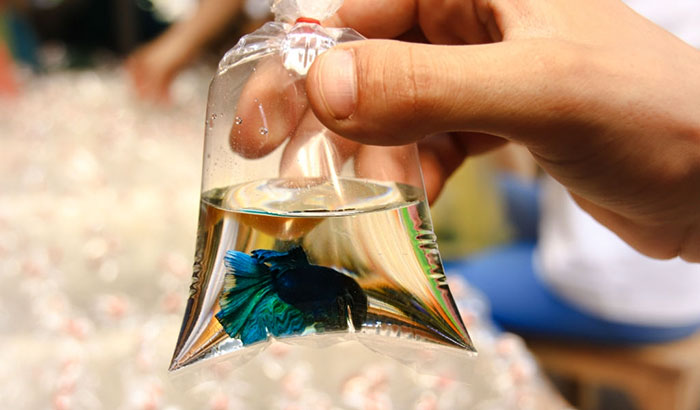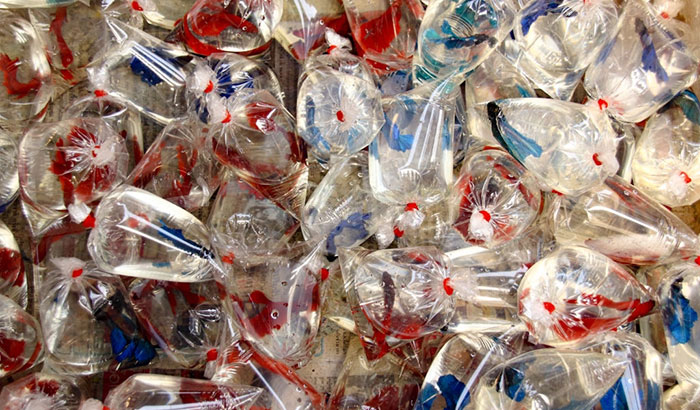Fish can be a very sensitive type of pet. They can die in the wrong water conditions, in an overpopulated tank, or due to the stress of transport. Betta fish, a popular pet fish, is a particularly sensitive fish. Any good aquarist should know how to transport a betta fish, as this species is a popular beginner and veteran aquarist pet. This post will teach you the basics of transporting a betta fish. We will consider aspects such as the trip length, the tank specifics, the road conditions, feeding, and more.
Contents
Step 1: Choose the Right “Tank Type”
Choosing the type of tank you will use depends on the length of the trip. The longer the trip, the more secure the tank type should be.
Tupperware for Long Trips
For example, if you’re going on a long multi-day trip, the fish will need a plastic container such as Tupperware that can hold at least half a gallon. A Tupperware is a good option because it is sturdy enough that it won’t have leaks after about a day or more on the road. It is also portable, which makes it perfect for long-distance travel.
Plastic Baggies for Short Trips
If you’re only going for a short trip that will take just a few hours, a plastic baggie might be the preferable option. You’d have to double the baggie, and they have to be ziplock, just to be safe. You might also need to put the baggies in a rigid container, especially if the road is bumpy.
But keep in mind that you have to open the container now and then to oxygenate the water. And if possible, try replacing the water every few hours. You can do this by taking out half of the container’s water and gently pouring in fresh water. Be very careful not to agitate the fish while doing this. You have to replace the water because the ammonia levels in the container will spike every twenty-four hours, which is terrible for the fish.
Step 2: Make the Water Familiar to the Betta Fish
To prevent your betta from stressing over the new, unfamiliar environment, make the new environment as familiar as possible. You can do this by ensuring that the water in the trip container is similar to the water in the betta’s tank at home. I suggest making partial water changes a couple of days before and the day before the trip.
You can use the partial tank water and mix it with fresh, clean water in the trip container. This way, the fish will not sense many changes in its environment. If you are going on a long trip, use the extra partial water from the two sets of changes you did before the trip.
The two advantages of this trick are:
- The water is still familiar to the fish
- The water is relatively clean and void of toxic substances like ammonia
The travel container’s water content should be half tank water and half fresh, clean water. The fresh and clean water should be pre-conditioned for betta residents. Use the same process you usually do when putting water in the betta tank at home. If you have to, use a betta-approved water conditioner.
Additionally, you may want to add a teaspoon of aquarium salt for every gallon of water for good measure.
Step 3: Make the Trip Smooth
A bumpy road will stress your poor betta to death, either literally or metaphorically. Try imagining yourself in a house that constantly shakes all around you for a reasonable amount of time. It’s scary and stressful. You can prevent your fish from experiencing the same predicament with a few tips and tricks.
How to Make the Trip Smooth
If possible, choose the smoothest roads possible. The lesser the bumps on the roads are, the less stressful it will be for the betta.
One tip you can use is to make use of the seatbelt. It may be challenging, and you may have to finagle your way around it, but a seatbelt can help keep the container securely in place.
Another trick you can do is place the container on the vehicle’s floor instead of on the seat. The car’s floor bumps around significantly less than the seats, which may be better. Just be sure that the air conditioning system is not blasting cold air on the container. You don’t want your fish getting uncomfortably cold.
Lastly, use towels or old shirts as a cushioning device for the container. You can use these items to keep the container as snug as possible. Additionally, old shirts or towels can help regulate the container’s temperature. It’s a big win!
Step 4: Choose – To Feed or Not to Feed?
It is best to transport a betta fish while it is fasting, but you’ve got to feed it sooner rather than later. You have to limit its food intake so that you can limit the waste in its trip-worthy tank. You have to make your fish fast at least one day a week to prevent it from bloating and constipation. If the trip is just a day-long, you can just skip the feeding altogether and make your betta fish fast.
However, betta fish are creatures of habit; they tend to get stressed when their scheduled feedings don’t happen. If you have an already established feeding routine, it might be best to just stick to it.
Conclusion
Bettas are pretty versatile pets despite being sensitive. As long as you make the proper preparations and make its traveling environment as familiar as possible, the fish should do fine. In summary, here’s how to transport a betta fish: get the appropriate container based on the trip length. Rigid, plastic containers are preferable for long trips, and plastic baggies are sufficient for short trips.
The water conditions should closely resemble the water conditions in the betta’s tank at home. Bumpy roads may affect the fish negatively, so try to keep its container as snug as possible to avoid shaking. If you can travel on smooth routes, do so. Lastly, keep the feeding habit as regular as possible since bettas love routine.


